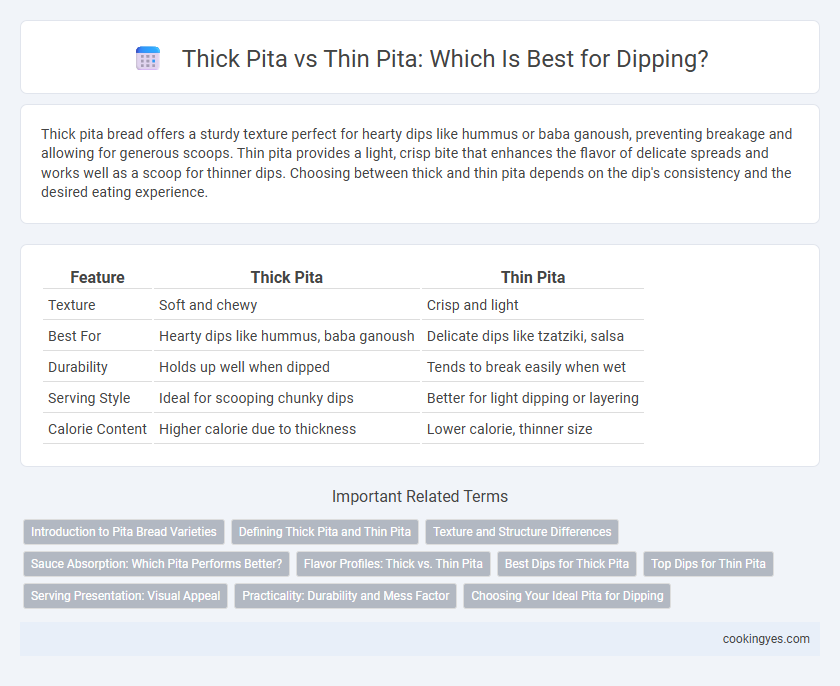Thick pita bread offers a sturdy texture perfect for hearty dips like hummus or baba ganoush, preventing breakage and allowing for generous scoops. Thin pita provides a light, crisp bite that enhances the flavor of delicate spreads and works well as a scoop for thinner dips. Choosing between thick and thin pita depends on the dip's consistency and the desired eating experience.
Table of Comparison
| Feature | Thick Pita | Thin Pita |
|---|---|---|
| Texture | Soft and chewy | Crisp and light |
| Best For | Hearty dips like hummus, baba ganoush | Delicate dips like tzatziki, salsa |
| Durability | Holds up well when dipped | Tends to break easily when wet |
| Serving Style | Ideal for scooping chunky dips | Better for light dipping or layering |
| Calorie Content | Higher calorie due to thickness | Lower calorie, thinner size |
Introduction to Pita Bread Varieties
Thick pita bread offers a soft, pocketed structure ideal for holding dips like hummus or baba ganoush, enhancing the dipping experience with its sturdy texture. Thin pita varieties, often crispier, provide a delicate balance perfect for scooping lighter dips, emphasizing flavor without overwhelming the palate. Understanding these pita bread differences helps in selecting the best option for various dipping styles.
Defining Thick Pita and Thin Pita
Thick pita features a soft, pillowy texture with a substantial crumb, perfect for absorbing dips without tearing, while thin pita is lighter and crispier, offering a delicate crunch that complements smooth dips. Thick pita often has a pocket that can be stuffed or torn for scooping, whereas thin pita is typically flexible and ideal for dipping in hummus or tzatziki. Both types enhance dipping experiences differently, with thickness influencing absorbency and texture.
Texture and Structure Differences
Thick pita features a dense, chewy texture with a sturdy structure that holds up well to heavy dips and chunky spreads. Thin pita offers a crispier, more delicate bite, allowing for easy scooping but may become soggy with liquid-based dips. The contrast in thickness directly affects the dipping experience, with thick pita providing ample support while thin pita enhances crispness and lightness.
Sauce Absorption: Which Pita Performs Better?
Thick pita excels in sauce absorption due to its dense, spongy texture that soaks up dips like hummus and tzatziki without disintegrating, providing a satisfying bite with every scoop. Thin pita offers a lighter, crisp texture but tends to absorb less sauce, often causing dips to pool on the surface rather than being fully absorbed. For rich, creamy sauces, thick pita performs better by maintaining structural integrity while maximizing flavor absorption.
Flavor Profiles: Thick vs. Thin Pita
Thick pita offers a chewy texture that absorbs and enhances rich, creamy dips like hummus and baba ganoush, intensifying their savory flavors. Thin pita delivers a crisp bite that pairs well with light, fresh dips such as tzatziki, highlighting their tangy and herbal notes. Choosing between thick and thin pita depends on balancing texture with the dip's flavor profile for the best tasting experience.
Best Dips for Thick Pita
Thick pita bread provides a sturdy and chewy texture that pairs exceptionally well with hearty dips like hummus, baba ganoush, and tzatziki, as it holds up without breaking apart. Its dense structure allows you to scoop up thicker or chunkier dips effectively, making each bite satisfying and flavorful. For optimal dipping experiences, choose rich, creamy, and Mediterranean-style dips that complement thick pita's substantial bite.
Top Dips for Thin Pita
Thin pita bread offers an ideal texture and size for dipping, allowing top dips like hummus, tzatziki, and baba ganoush to cling perfectly without overpowering each bite. Its delicate crispness and flexible structure enhance the flavors of smooth, creamy dips, making each scoop satisfying and balanced. Popular dipping choices with thin pita emphasize vibrant spices and fresh herbs, complementing its light, airy profile.
Serving Presentation: Visual Appeal
Thick pita offers a hearty, rustic appearance that complements chunky dips like hummus or baba ganoush, enhancing the visual appeal with its substantial texture and golden-brown exterior. Thin pita, with its delicate, crispy edges and lighter color, creates an elegant presentation ideal for smooth, finely textured dips such as tzatziki or olive tapenade. Both options visually elevate serving platters by balancing color, texture, and shape, making them perfect choices for varying dipping experiences.
Practicality: Durability and Mess Factor
Thick pita offers superior durability for dipping, preventing easy tearing and making it ideal for hearty dips like hummus or baba ganoush. Thin pita, while lighter and crispier, tends to become soggy quickly and may break apart when scooping dense or oily dips. For practicality, thick pita reduces mess by holding substantial portions without dripping, enhancing the dipping experience.
Choosing Your Ideal Pita for Dipping
Thick pita offers a sturdy texture that holds up well to heavy dips like hummus or baba ganoush, preventing sogginess and enhancing the dipping experience. Thin pita provides a lighter, crispier bite, ideal for smoother and less dense dips such as tzatziki or olive tapenade, allowing for a balanced flavor without overwhelming the palate. Selecting the ideal pita depends on the dip's consistency and desired mouthfeel, ensuring each scoop maintains structural integrity and delivers optimal taste.
Thick Pita vs Thin Pita for Dipping Infographic

 cookingyes.com
cookingyes.com